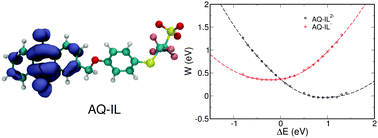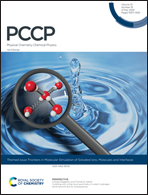A first-principles investigation of the structural and electrochemical properties of biredox ionic species in acetonitrile†‡
Abstract
Biredox ionic liquids are a new class of functionalized electrolytes that may play an important role in future capacitive energy storage devices. By allowing additional storage of electrons inside the liquids, they can improve device performance significantly. However current devices employ nanoporous carbons in which the diffusion of the liquid and the adsorption of the ions could be affected by the occurrence of electron-transfer reactions. It is therefore necessary to understand better the thermodynamics and the kinetics of such reactions in biredox ionic liquids. Here we perform ab initio molecular dynamics simulations of both the oxidized and reduced species of several redox-active ionic molecules (used in biredox ionic liquids) dissolved in acetonitrile solvent and compare them with the bare redox molecules. We show that in all the cases, it is necessary to introduce a two Gaussian state model to calculate the reaction free energies accurately. These reaction free energies are only slightly affected by the presence of the IL group on the molecule. We characterize the structure of the solvation shell around the redox active part of the molecules and show that in the case of TEMPO-based molecules strong reorientation effects occur during the oxidation reaction.

- This article is part of the themed collections: 2020 PCCP HOT Articles and Frontiers in Molecular Simulation of Solvated Ions, Molecules and Interfaces


 Please wait while we load your content...
Please wait while we load your content...